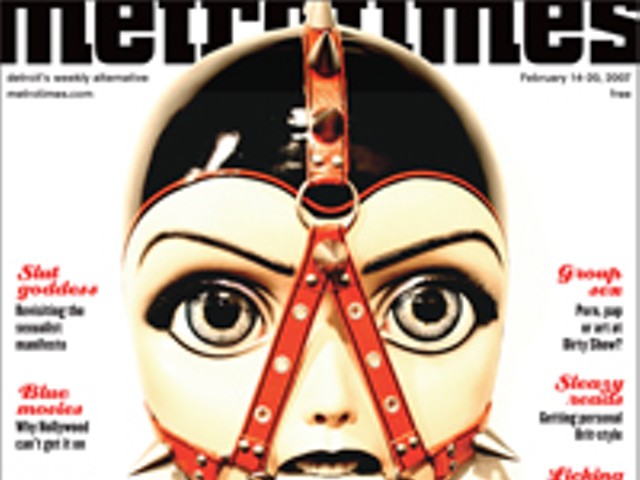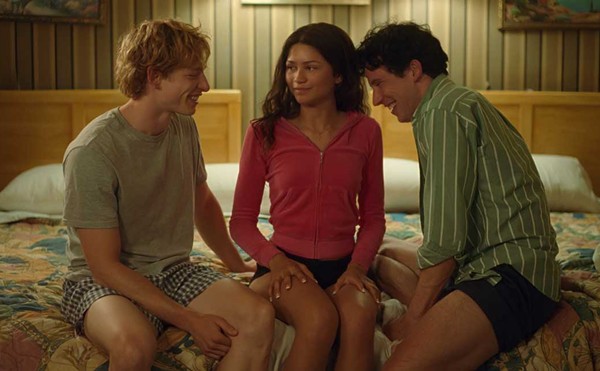Does everything in Detroit have to become art to become real?
Now more than ever, it sure seems like it. I can't count the number of artists documenting the lost lives and stories in this city by drawing pictures of run-down neighborhoods, recording anecdotes from senior citizens' pasts and photographing the homeless, jobless and mentally ill.
Art critic Glen Mannisto says, "We are at the height of aestheticizing the derelict. Detroit has become a nostalgia theme park. A graceless transformation is taking place." Meanwhile, the future doesn't look so bright, what with new casinos and parking structures blocking light. It's time for a different approach.
I want rather than hope that Shrinking Cities provides several. This exhibition reflects on urban decay and depopulation, and imagines alternatives. Initiated five years ago by Germany's Federal Cultural Foundation, it examines devolution and disinvestment in Detroit, Ivanavo (Russia), Manchester/Liverpool (England) and Halle/Leipzig (Germany).
Urban planner Constance C. Bodurow's essay is the first in a series that examines Shrinking Cities in hopes of creating a dialogue about it. —Rebecca Mazzei, Metro Times arts and culture editor
During a recent gallery talk at MOCAD, curator Philipp Oswalt seemed to want to reassure his audience when he said, "You are not alone." By presenting the cold hard facts, asking fundamental questions and offering possible plans for action, Shrinking Cities should, firstly, convince us that Detroit shares an urban condition with other cities, and secondly, encourage us to embrace the artist's role in providing possible solutions.
Shrinking Cities is dramatic, ambitious in its scope, scale and stated goal to "... unite the city and the suburbs in ... dialogue about new urban models." Congratulations go to curators and sponsors, especially since controversy prompted several cities and venues to reject the exhibition. While I hesitate to be critical of a creative venture of this stature (we need more, not less of this, in Detroit), I found myself asking: Can something be morbid and optimistic at the same time? Evidence of that exists in this largely dissatisfying exercise, one that is also punctuated by artful and inspiring moments.
This is an exhibition about cities — four proud yet wounded cities whose patriarchal structures have failed them and so portray the most exaggerated examples of urban "shrinkage."
As an urbanist, I appreciate the identification of the phenomenon and the raised awareness that this German-catalyzed, well-funded initiative has brought. Both are worthy contributions to the global dialogue on cities, and I attended with anticipation, looking forward to the culmination of five years of hype within international artistic, architectural and academic circles. Unfortunately, I came away unsatisfied by the aesthetic emphasis on each city's morbid state, the sentimental responses and the precious few truly relevant recommendations to prompt improvement in the urban and human condition. Ambition may have gotten in the way. The intervening three years since local "experts" gathered data and created working papers have seen significant physical and psychological change in Detroit and the other cities. The style and content of the exhibition matches Detroit's 1990s zeitgeist more so than that of today.
The extensive data on display at Cranbrook are indeed impressive, and some of the presentation techniques clever. The exhibit has a very Deutsche feel — each city getting two large-scale wall panels of introductory narrative and chronology rendered in crisp black and white text and images like a snapshot of mid-20th century film noir. Each city is an example of a specific strain of depopulation (for instance, Detroit is a product of suburbanization) and each city has its own industrial raison d'être, whether chemicals, autos, cotton or textiles, as well as parallel strains of social unrest and cultural traditions forged from its deindustrializing crucible.
Here is where the morbid nostalgia kicks in: Detroit is predictably rendered in all the "usual suspects" of our globalized image: aerial views of abandoned auto factories and neighborhoods, Motown as we used to know it and the '67 riots/civil insurrection. This superficial and image-based knowledge of place, no matter how well intentioned, is evident. For over a decade, beginning with Camillo Vergara's now-infamous photographs documenting empty skyscrapers downtown and dilapidated homes, East Coast and European intellects have cultivated a dark fascination with Detroit, focusing on our decaying landscape and resilient culture, all cued to a techno soundtrack.
The text panels express this fascination and a barely hidden agenda that Detroit is expected to remain frozen in time — a devastated palette ripe for creation. Reading Detroit's introductory story, I began to question some of the conclusions, such as this one: "... suburbanization occurred in Detroit because whites left the city." While statistics support this statement, anyone who observed the demographics of Shrinking Cities' opening reception attendance might question it. The accurate statement would involve wealth leaving the city, which is a more interesting and relevant statistic that should have been mapped. Artists' pieces at Cranbrook were intermingled with the data, and some, such as John Ganis' series of photographs "The Changing Landscape of The Detroit Metropolitan Area," provide original and unsentimental commentary on voracious suburban scale development, consumption of landscape and impact on the urban core. But moments of inspiration were drowned out by the ubiquitous streaming video and photography of deteriorated, abandoned landscapes, all of which document a brief period in time for each shrinking city and produces, intended or not, a numbing affect.
It is unfortunate that organizers relegated the exhibit pertaining to Ivanovo, Russia, to Cranbrook museum's basement. Here, I found more attention to the human condition, with the mesmerizing video projection "Banka Supa (A Glass of Soup)" by Sergei Bratkov, and the stark form and commentary of Sergei and Savva Miturich, Alexander Sverdlov and Boris Spiridonov's "Survival Manual," a black and white booklet documenting practices people employ in their postindustrial economy. Both pieces unsentimentally chronicle the challenges of sustaining life.
MOCAD's portion of the exhibition presents artists' "interventions" — some a result of the 2004 international competition, some invited, all organized around five declarative statements (each of which is reproduced as a color poster). Color is purposely used here, contrasting the more subdued Cranbrook installation, to good effect. The opening panel boldly claims "classic urban design and city planning has come up against its limits" in the face of shrinking cities. Curator Oswalt then chooses to show us theoretical approaches from the 1960s and '70s (Cedric Price, Superstudio, Robert Smithson et al.) – which I found to be a distraction. Similarly distracting, though slightly more recent, was the inclusion of landscape urbanism progenitor Charles Waldheim's "Decamping Detroit." This pioneer identifies vacancy and abandonment as our primary assets, recommends the reversion of Detroit's once-densely-built acreage to vast natural or cultivated areas and condescends to residual human use.
If the intent was to displace "classic" approaches, then surely, I thought, I would see the interventions address the issues facing the citizens of the city: housing, mobility, employment and providing for and raising children in a challenged economic climate. But such interventions were few and far between. Only Center for Urban Pedagogy's work, "However Unspectacular: The New Suburbanism/Detroit Do Your Thing!" which revealed, through mapping and graphics, neighborhood ownership and use, as well as recommended tools for high-school level education and engagement, attempted to address such "classic" issues. The pieces I found compelling (unsurprisingly) focused on the self-sufficiency that most Detroiters have adopted over the last 30 years. Mitch Cope, Ingo Vetter and Annette Wiesser's installation "Detroit Tree of Heaven Woodshop," using the indigenous and ubiquitous weed as a resource, Ingo Vetter's photo documentation of "Detroit Industries – Urban Agriculture" and Pierre Huyghe's "Mediterranean Structures" photographs, documenting ever-evolving skeleton houses, elegantly address the basics of self-determination, food production, and economic and environmental sustainability in the urban context.
Art should be enough, and in other cities and political realities, a show big on drama and short on possibilities may be just what the doktor ordered to prompt change. But, in Detroit, where we wear our fierce pride and paralyzing shame on our sleeve just above thin skin, we need more. We want and expect fresh perspective from outside commentators that will point a way out of our current urban and regional condition.
As a Detroit resident, I'm a bit cynical, given the massive structural issues with which we wrestle, though I acknowledge progress over the years since the exhibition's initiative began. While I don't subscribe to the popular civic boosterism as a substitute for smart, funded urban policy, I also question the extreme lens of Shrinking Cities. There is a vast middle ground of day-to-day life where most citizens of a shrinking city live — not in survival mode in the midst of a bleak landscape, as is the romanticized, extreme urbanism presented here. This middle ground isn't very sexy, but it's the fertile ground that has yet to be addressed. The curators and artists have delivered their provocative position, asking us to ponder Detroit's future.
I hope that Shrinking Cities' extensive public programming over the next two months will help facilitate this, and that some of the artists will continue to work with us. Without that, I am left feeling that we are indeed alone — not in experiencing the phenomenon, but more importantly, in where we go next.
Shrinking Cities runs through April 1 at Museum of Contemporary Art Detroit, 4454 Woodward Ave., Detroit; 313-832-6622 and Cranbrook Art Museum, 39221 Woodward Ave., Bloomfield Hills; 248-462-7262. Admission is free.
Frank Pahl and Dan DeMaggio perform music and a monologue respectively at 9 p.m., Friday, Feb. 16 at MOCAD. Cranbrook grad students talk about "ideas and process" at 1:30 p.m., Saturday, Feb. 17 at Cranbrook. Films, including Detroit Park and Detroit Block by Julie Murray, Invisible City by Jack Cronin, Vacancy by Brandon Walley and I Pity the Fool by Brent Coughenhour show at 7 p.m., also on Saturday, at MOCAD. Participating artists Christopher McNamara and John Ganis give a gallery talk at 1:30 p.m., Sunday, Feb. 18 at Cranbrook.
Constance C. Bodurow is founding principal of Design Equity Urban Design + Planning and teaches urban design at Wayne State University and University of Detroit Mercy. Send comments to [email protected].




